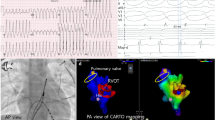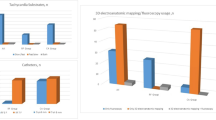Abstract
Background
AV nodal reentrant tachycardia (AVNRT) is commonly encountered in pediatric patients. Definite treatment can be achieved by catheter ablation. The purpose of the study was to evaluate the efficacy and safety of AVNRT ablation focusing on children with a body weight ≤25 kg.
Patients and results
Catheter ablation of AVNRT was attempted in 253 patients. Median age was 12.5 years; median body weight was 48.7 kg. 25 (9.9 %) children had a body weight ≤25 kg. Congenital heart disease was present in 6 patients (2.4 %). Procedural success was achieved in 98 % using radiofrequency, in 100 % using cryoenergy alone, and in 94 % using both energy sources. In patients with a body weight ≤25 kg, success was achieved in 96 %. In patients ≤25 kg, fluoroscopy and procedure duration did not differ from those >25 kg. The rate of major complications was significantly higher in the patients ≤25 kg (12 vs. 2.2 %, p = 0.04). Permanent AV block after RF ablation occurred in 2 patients with congenital heart disease and one infant with a body weight of 8.7 kg.
Conclusions
Catheter ablation of AVNRT in children and adolescents was safe and effective. Infants and small children with a body weight ≤25 kg had a higher prevalence of serious complications. This should alert physicians in decision making toward catheter ablation in these patients. In patients with congenital heart disease and different anatomy of the cardiac conduction system, operators must be aware of an increased risk for AV block.
Similar content being viewed by others
References
Kugler JD, Danford DA, Houston KA, Felix G, Pediatric Radiofrequency Ablation Registry of the Pediatric Radiofrequency Ablation Registry of the Pediatric Electrophysiology S (2002) Pediatric radiofrequency catheter ablation registry success, fluoroscopy time, and complication rate for supraventricular tachycardia: comparison of early and recent eras. J Cardiovasc Electrophysiol 13:336–341
Van Hare GF, Javitz H, Carmelli D, Saul JP, Tanel RE, Fischbach PS, Kanter RJ, Schaffer M, Dunnigan A, Colan S, Serwer G (2004) Prospective assessment after pediatric cardiac ablation: demographics, medical profiles, and initial outcomes. J Cardiovasc Electrophysiol 15:759–770
Kriebel T, Broistedt C, Kroll M, Sigler M, Paul T (2005) Efficacy and safety of cryoenergy in the ablation of atrioventricular reentrant tachycardia substrates in children and adolescents. J Cardiovasc Electrophysiol 16:960–966
Kubus P, Vit P, Gebauer RA, Zaoral L, Peichl P, Fiala M, Janousek J (2014) Long-term results of paediatric radiofrequency catheter ablation: a population-based study. Europace 16:1808–1813
Kugler JD, Danford DA, Houston K, Felix G (1997) Radiofrequency catheter ablation for paroxysmal supraventricular tachycardia in children and adolescents without structural heart disease. Pediatric EP Society, Radiofrequency Catheter Ablation Registry. Am J Cardiol 80:1438–1443
Kugler JD, Danford DA, Deal BJ, Gillette PC, Perry JC, Silka MJ, Van Hare GF, Walsh EP (1994) Radiofrequency catheter ablation for tachyarrhythmias in children and adolescents. The Pediatric Electrophysiology Society. N Engl J Med 330:1481–1487
Ko JK, Deal BJ, Strasburger JF, Benson DW Jr (1992) Supraventricular tachycardia mechanisms and their age distribution in pediatric patients. Am J Cardiol 69:1028–1032
LaPage MJ, Reed JH, Collins KK, Law IH, Pilcher TA, Tanel RE, Anderson CC, Young ML, Emmel M, Paul T, Blaufox AD, Arora G, Saul JP (2011) Safety and results of cryoablation in patients <5 years old and/or <15 kilograms. Am J Cardiol 108:565–571
Blaufox AD, Saul JP (2004) Acute coronary artery stenosis during slow pathway ablation for atrioventricular nodal reentrant tachycardia in a child. J Cardiovasc Electrophysiol 15:97–100
Schneider HE, Kriebel T, Gravenhorst VD, Paul T (2009) Incidence of coronary artery injury immediately after catheter ablation for supraventricular tachycardias in infants and children. Heart Rhythm 6:461–467
Denes P, Wu D, Dhingra R, Amat-y-Leon F, Wyndham C, Rosen KM (1975) Dual atrioventricular nodal pathways. A common electrophysiological response. Brit Heart J 37:1069–1076
Bertram H, Windhagen-Mahnert B, Bokenkamp R, Kriebel T, Peuster M, Hausdorf G, Paul T (2001) Abbreviated combined anatomical/electrophysiological approach for catheter ablation of atrioventricular nodal reentrant tachycardia in children. Cardiol Young 11:182–187
Jackman WM, Beckman KJ, McClelland JH, Wang X, Friday KJ, Roman CA, Moulton KP, Twidale N, Hazlitt HA, Prior MI et al (1992) Treatment of supraventricular tachycardia due to atrioventricular nodal reentry, by radiofrequency catheter ablation of slow-pathway conduction. N Engl J Med 327:313–318
Manolis AS, Wang PJ, Estes NA 3rd (1994) Radiofrequency ablation of slow pathway in patients with atrioventricular nodal reentrant tachycardia. do arrhythmia recurrences correlate with persistent slow pathway conduction or site of successful ablation? Circulation 90:2815–2819
Feldman A, Voskoboinik A, Kumar S, Spence S, Morton JB, Kistler PM, Sparks PB, Vohra JK, Kalman JM (2011) Predictors of acute and long-term success of slow pathway ablation for atrioventricular nodal reentrant tachycardia: a single center series of 1,419 consecutive patients. Pacing Clin Electrophysiol 34:927–933
Lee PC, Hwang B, Chen SA, Tai CG, Chen YJ, Chiang CE, Meng CC (2007) The results of radiofrequency catheter ablation of supraventricular tachycardia in children. Pacing Clin Electrophysiol 30:655–661
Joung B, Lee M, Sung JH, Kim JY, Ahn S, Kim S (2006) Pediatric radiofrequency catheter ablation: sedation methods and success, complication and recurrence rates. Circ J 70:278–284
Brugada J, Blom N, Sarquella-Brugada G, Blomstrom-Lundqvist C, Deanfield J, Janousek J, Abrams D, Bauersfeld U, Brugada R, Drago F, de Groot N, Happonen JM, Hebe J, Yen Ho S, Marijon E, Paul T, Pfammatter JP, Rosenthal E, European Heart Rhythm A, Association for European P, Congenital C (2013) Pharmacological and non-pharmacological therapy for arrhythmias in the pediatric population: EHRA and AEPC-Arrhythmia Working Group joint consensus statement. Europace 15:1337–1382
Crosson JE, Hesslein PS, Thilenius OG, Dunnigan A (1995) Av node reentry tachycardia in infants. Pacing Clin Electrophysiol 18:2144–2149
Kriebel T, Bertram H, Windhagen-Mahnert B, Bokenkamp R, Kaulitz R, Rohloff A, Peuster M, Hausdorf G, Paul T (2000) atrioventricular nodal reentry tachycardia in children: curative treatment by high frequency catheter ablation. Z Kardiol 89:538–545
Miyake CY, Mah DY, Atallah J, Oikle HP, Melgar ML, Alexander ME, Berul CI, Cecchin F, Walsh EP, Triedman JK (2011) Nonfluoroscopic imaging systems reduce radiation exposure in children undergoing ablation of supraventricular tachycardia. Heart Rhythm 8:519–525
Mah DY, Miyake CY, Sherwin ED, Walsh A, Anderson MJ, Western K, Abrams DJ, Alexander ME, Cecchin F, Walsh EP, Triedman JK (2014) The use of an integrated electroanatomic mapping system and intracardiac echocardiography to reduce radiation exposure in children and young adults undergoing ablation of supraventricular tachycardia. Europace 16:277–283
Reithmann C, Fiek M (2014) Fast pathway ablation for atrioventricular nodal reentrant tachycardia with a marked pr interval prolongation during sinus rhythm following transcatheter aortic valve implantation. Clin Res Cardiol 103:495–498
Aiyagari R, Saarel EV, Etheridge SP, Bradley DJ, Dick M 2nd, Fischbach PS (2005) Radiofrequency Ablation for Supraventricular Tachycardia in Children < or = 15 Kg Is Safe and Effective. Pediatr Cardiol 26:622–626
Conflict of interest
The authors have no conflicts of interest to disclose.
Author information
Authors and Affiliations
Corresponding author
Additional information
U. Krause and D. Backhoff contributed equally to this work.
Rights and permissions
About this article
Cite this article
Krause, U., Backhoff, D., Klehs, S. et al. Catheter ablation of pediatric AV nodal reentrant tachycardia: results in small children. Clin Res Cardiol 104, 990–997 (2015). https://doi.org/10.1007/s00392-015-0868-6
Received:
Accepted:
Published:
Issue Date:
DOI: https://doi.org/10.1007/s00392-015-0868-6




